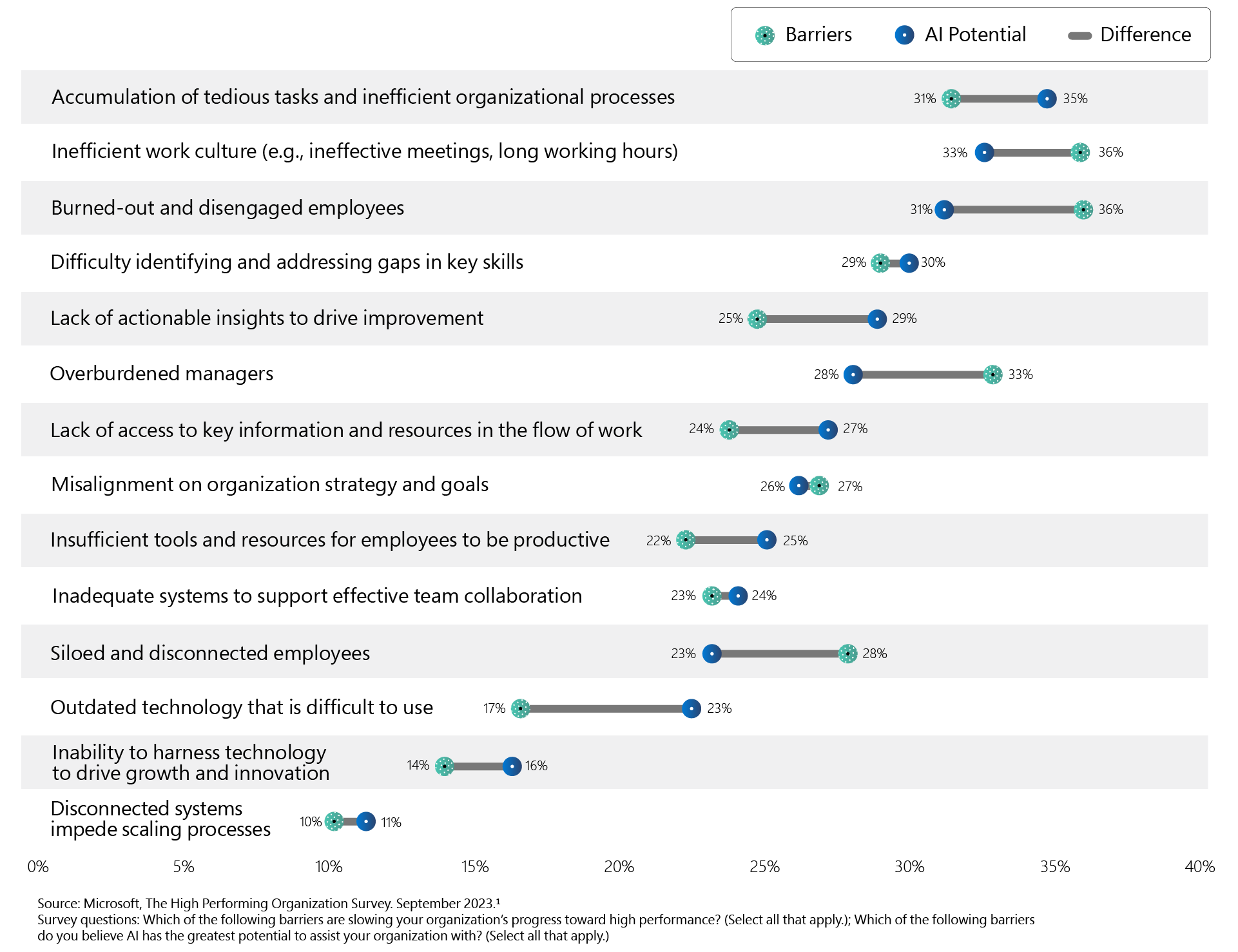The burdens of work have increased significantly in a hybrid world. A recent Microsoft study, which surveyed more than 30,000 people worldwide and analyzed trillions of anonymized and aggregated activity signals gleaned from Microsoft 365 products, found that the amount of time spent in Microsoft Teams meetings and calls has increased threefold since 2020—and respondents said that inefficient meetings were the number one disruptor to their productivity.4 The study also found that 64 percent of people have struggled with finding time and energy to get their work done, and those workers are more than three times as likely to say they struggle with innovation.4
It comes as no surprise, then, that leaders in our HPO survey said the biggest barriers to their organization’s progress toward high performance were burned-out and disengaged employees (36%); inefficient work culture, which included endless meetings and excessive working hours (36%); overburdened managers (33%); accumulation of tedious tasks (31%); and difficulty identifying and addressing gaps in key skills (29%).
When asked which barriers AI had the best potential to address, leaders cited the same issues, with the accumulation of tedious tasks cited most (35%), followed by inefficient work culture (33%), burned-out and disengaged employees (31%), difficulty identifying and addressing gaps in key skills (30%), and overburdened managers (28%).
AI Assist
AI capabilities are uniquely well suited to overcoming the barriers to high performance.


It’s clear that leaders see AI as an accelerant to high performance, and this aligns with prior Microsoft research that found that leaders are twice as likely to say that AI will provide value by boosting productivity than they are to say it will reduce headcount. And employees are inclined to agree: they are more excited about AI’s potential to reduce the burden of their work than they are worried that AI will replace their jobs.4
The leaders we surveyed reported that their organizations have made an average of five AI-related investments, with the majority of them focused on building the foundation for AI adoption, including data infrastructure, upskilling their workforce to use AI, and identifying the business objectives of AI adoption.1
Unsurprisingly, the 15 percent of leaders whose organizations are HPOs by our definition reported making meaningful strides with AI investments. Half of these HPO leaders said their organizations have invested in AI for specific employee experience use cases, compared to 39 percent of typical organizations. HPO leaders were also significantly more likely to see the potential of AI to help identify and address gaps in key skills (42%)—a key factor in supporting innovation and building organizational resilience—
than leaders of typical organizations (28%).
In the future, AI proficiency will be foundational to performance. “We’re going to have to re-gear our people to take advantage of the AI era,” Duncan says. “It’s not only about learning new skills, but creating new habits in how people approach work, how they solve problems, and how they foster creativity.”
Hidden Opportunities
Leaders see the potential for AI to help with people-centric solutions, such as reducing tedious tasks and inefficiencies and managing burnout and disengagement. They also recognize the potential of AI to strengthen core organizational capabilities like addressing gaps in important skills and surfacing insights that can drive improvement.
Additionally, results from the HPO survey show that there are opportunities for AI to enhance the employee experience in ways that leaders don’t yet recognize, such as creating connections between siloed employees and reducing the burden on managers. When AI helps minimize the barriers that slow progress toward HPO goals, there are secondary effects as well: employees have time and energy to focus on the work they care about most, and that engagement impacts performance.
“When people feel like their work matters and they’re able to do meaningful work in a productive way, that equates to being more engaged,” Patton says. “It’s a virtuous cycle.”
Sweat the Hard Stuff
The most important drivers of high performance are also the hardest to master.
Performance Is about More than Profits
The new performance dashboard shows that financial success isn’t the whole story.
Double Down on Deep Collaboration
Leaders say they frequently work together, but relatively few engage in the difficult work of real partnership.
